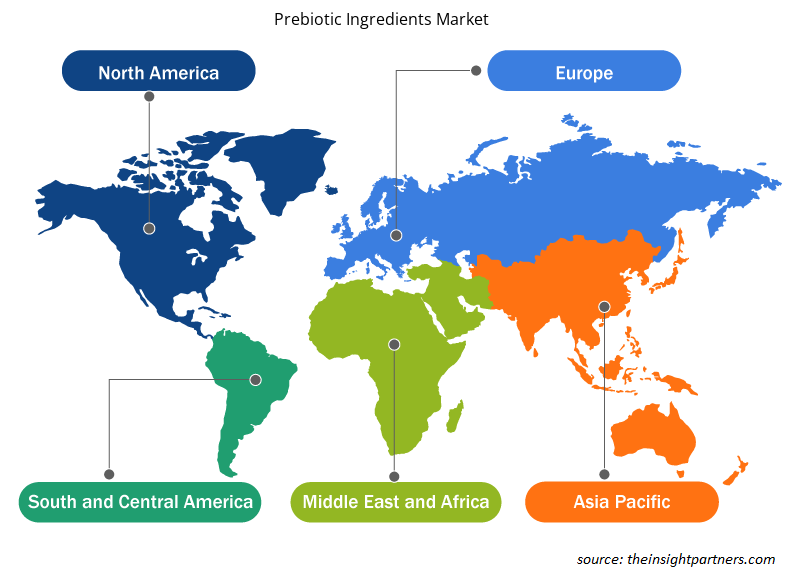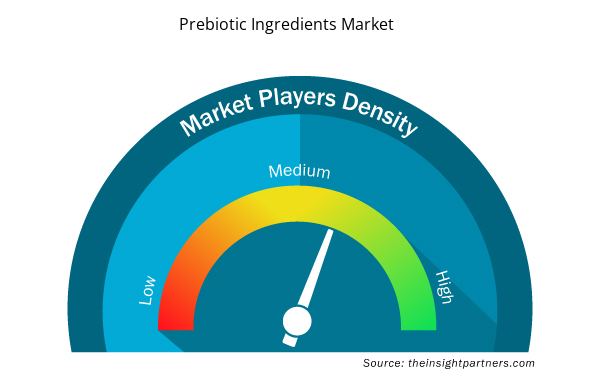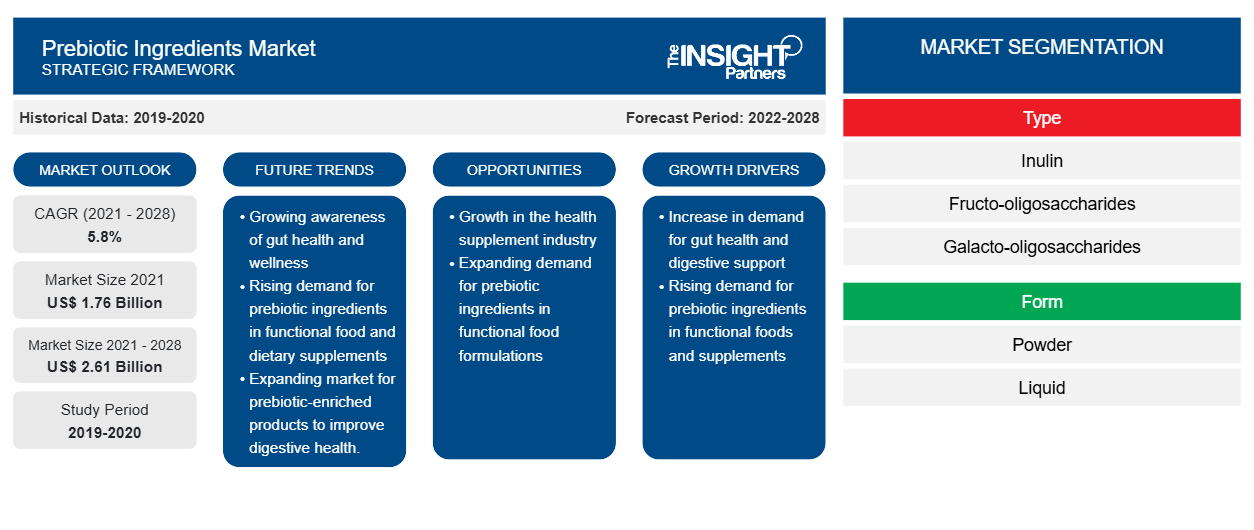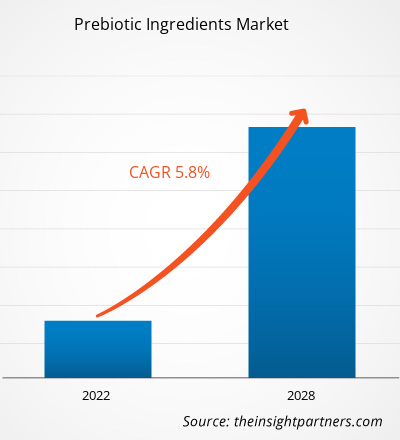[Rapporto di ricerca] Si prevede che il mercato degli ingredienti prebiotici crescerà da 1.758,40 milioni di dollari nel 2021 a 2.607,72 milioni di dollari entro il 2028; si prevede che crescerà a un CAGR del 5,8% dal 2022 al 2028.
I prebiotici sono composti presenti negli alimenti che inducono la crescita o l'attività di microrganismi benefici come batteri e funghi. La fermentazione è il principale meccanismo d'azione mediante il quale i batteri benefici utilizzano i prebiotici nel colon. I prebiotici svolgono un ruolo significativo nell'assistenza sanitaria preventiva poiché la crescente popolarità degli integratori nutraceutici ricchi di fibre tra gli appassionati di sport e gli atleti per aumentare la loro resistenza e tenacia aumenta ulteriormente la domanda di ingredienti prebiotici . Pertanto, la crescente consapevolezza riguardo all'assistenza sanitaria preventiva sta aumentando la crescita del mercato degli ingredienti prebiotici .
L'Asia Pacifica ha detenuto la quota di mercato più grande degli ingredienti prebiotici nel 2021, mentre altre regioni in via di sviluppo, come Medio Oriente e Africa, dovrebbero crescere in modo significativo nel periodo di previsione. La crescita del mercato è attribuita all'aumento della salute intestinale e dei disturbi della salute immunitaria, associati alle crescenti malattie digestive. I paesi asiatici sono inclini ad adottare alimenti e bevande sani e nutrienti per migliorare la salute intestinale. Quindi, l'inclinazione ad adottare cibi sani sta guidando la crescita del mercato degli ingredienti prebiotici .
Personalizza questo report in base alle tue esigenze
Riceverai la personalizzazione gratuita di qualsiasi report, comprese parti di questo report, o analisi a livello nazionale, pacchetto dati Excel, oltre a usufruire di grandi offerte e sconti per start-up e università
- Scopri le principali tendenze di mercato in questo rapporto.Questo campione GRATUITO includerà analisi di dati che spaziano dalle tendenze di mercato alle stime e alle previsioni.
Impatto della pandemia di COVID-19 sul mercato degli ingredienti prebiotici
La pandemia di COVID-19 ha portato sfide senza precedenti per molti settori all'inizio del 2020. Lockdown , restrizioni alle frontiere, divieti di viaggio, interruzione della produzione e altre misure di sicurezza implementate dai governi secondo le linee guida dell'OMS e dei ministeri della salute nazionali hanno ostacolato le operazioni di produzione. Tuttavia, lo scoppio del COVID-19 ha avuto un impatto positivo sul mercato poiché i consumatori cercavano sempre più alternative naturali e più sicure per mantenersi in salute e rafforzare il proprio sistema immunitario. La domanda di integratori alimentari è aumentata drasticamente durante i primi mesi della pandemia di COVID-19. Inoltre, poiché le persone sono rimaste a casa a causa dei mandati governativi, si sono concentrate sulla loro salute e forma fisica, stimolando la domanda di prebiotici durante la pandemia di COVID-19.
Approfondimenti di mercato
Crescente domanda di ingredienti prebiotici nel settore alimentare e delle bevande
La popolarità dei prebiotici sta aumentando nel settore alimentare e delle bevande grazie alla loro applicazione in barrette nutrizionali, latticini, bevande salutari, integratori minerali, cereali per la colazione, prodotti da forno, dolciumi, cibi verdi e formule per neonati. A novembre 2018, la Kellogg Company ha lanciato un nuovo cereale, con il marchio HI! Happy Inside, che include prebiotici e probiotici, come parte della sua linea di prodotti digestivi che migliorano l'intestino. Inoltre, l'inulina è ampiamente utilizzata nella lavorazione alimentare in quanto è un sostituto buono e sano di grassi e zuccheri. I principali paesi produttori di latte come Stati Uniti, India e Cina utilizzano i prebiotici per fornire la consistenza desiderata ai prodotti finali e realizzare latticini senza zucchero. Inoltre, le formule per neonati o gli alimenti per bambini contengono vari ingredienti prebiotici, tra cui galatto-oligosaccaridi, frutto-oligosaccaridi e polidestrosio. Questi sono i fattori che guidano la crescita del mercato degli ingredienti prebiotici.
Informazioni basate sul tipo
In base al tipo, il mercato degli ingredienti prebiotici è segmentato in inulina, fruttooligosaccaridi (FOS), galattooligosaccaridi (GOS), mannanooligosaccaridi (MOS) e altri. Si prevede che il segmento dell'inulina registrerà la quota maggiore durante il periodo di previsione. I produttori la utilizzano in alimenti e bevande trasformati, integratori alimentari e mangimi per animali per sostituire zucchero, grassi e farina. Negli Stati Uniti nel 2018, la Food and Drug Administration ha approvato l'inulina come ingrediente di fibre alimentari per migliorare il valore nutrizionale dei prodotti alimentari lavorati. Inoltre, la crescente domanda di prodotti naturali aumenta la domanda di inulina prebiotica in tutto il mondo. La crescita del segmento dell'inulina è guidata dalla crescente applicazione in vari settori, alimentando la crescita del mercato degli ingredienti prebiotici.
Informazioni basate su moduli
In base alla forma, il mercato degli ingredienti prebiotici è segmentato in polvere e liquido. Si prevede che il segmento in polvere registrerà un CAGR più elevato nel mercato durante il periodo di previsione. La forma in polvere ha reso facile la distribuzione e l'utilizzo del consumo di prebiotici. Il vantaggio di utilizzare polvere prebiotica per la produzione di bestiame sta guadagnando popolarità poiché i prebiotici in polvere sono accessibili per il consumo in qualsiasi fase della vita del bestiame. Inoltre, la crescente produttività di carni, uova e latte aumenta la domanda di prebiotici in polvere.
Approfondimenti basati sulle applicazioni
In base all'applicazione, il mercato degli ingredienti prebiotici è segmentato in alimenti e bevande funzionali, integratori alimentari, mangimi per animali e altri. Si prevede che il segmento degli integratori alimentari registrerà il CAGR più elevato nel mercato durante il periodo di previsione. La crescente domanda di medicinali preventivi, un numero crescente di disturbi digestivi tra gli anziani e la mancanza di una dieta equilibrata probabilmente aumenteranno la domanda di prodotti nel settore degli integratori alimentari. I consumatori preferiscono sempre di più gli integratori alimentari a base di prebiotici a causa della crescente adozione di diete non sane.
I principali attori che operano nel mercato degli ingredienti prebiotici sono BENEO GmbH; COSUCRA; DuPont Nutrition & Biosciences; Clasado Ltd.; Nexira; Ingredion Incorporated; SOLACTIS; Cargill, Incorporated.; Sensus; e Roquette Frères. Questi attori sono impegnati nello sviluppo di prodotti con rischi per la salute ridotti per soddisfare le tendenze emergenti dei consumatori e rispettare i quadri normativi. Sono coinvolti in fusioni e acquisizioni, espansioni aziendali e partnership per espandere la loro quota di mercato.
Approfondimenti regionali sul mercato degli ingredienti prebiotici
Le tendenze regionali e i fattori che influenzano il mercato degli ingredienti prebiotici durante il periodo di previsione sono stati ampiamente spiegati dagli analisti di Insight Partners. Questa sezione discute anche i segmenti e la geografia del mercato degli ingredienti prebiotici in Nord America, Europa, Asia Pacifico, Medio Oriente e Africa e America meridionale e centrale.

- Ottieni i dati specifici regionali per il mercato degli ingredienti prebiotici
Ambito del rapporto di mercato sugli ingredienti prebiotici
| Attributo del report | Dettagli |
|---|---|
| Dimensioni del mercato nel 2021 | 1,76 miliardi di dollari USA |
| Dimensioni del mercato entro il 2028 | 2,61 miliardi di dollari USA |
| CAGR globale (2021 - 2028) | 5,8% |
| Dati storici | 2019-2020 |
| Periodo di previsione | 2022-2028 |
| Segmenti coperti | Per tipo
|
| Regioni e Paesi coperti | America del Nord
|
| Leader di mercato e profili aziendali chiave |
|
Densità degli attori del mercato degli ingredienti prebiotici: comprendere il suo impatto sulle dinamiche aziendali
Il mercato degli ingredienti prebiotici sta crescendo rapidamente, spinto dalla crescente domanda degli utenti finali dovuta a fattori quali l'evoluzione delle preferenze dei consumatori, i progressi tecnologici e una maggiore consapevolezza dei benefici del prodotto. Con l'aumento della domanda, le aziende stanno ampliando le loro offerte, innovando per soddisfare le esigenze dei consumatori e capitalizzando sulle tendenze emergenti, il che alimenta ulteriormente la crescita del mercato.
La densità degli operatori di mercato si riferisce alla distribuzione di aziende o società che operano in un particolare mercato o settore. Indica quanti concorrenti (operatori di mercato) sono presenti in un dato spazio di mercato in relazione alle sue dimensioni o al valore di mercato totale.
Le principali aziende che operano nel mercato degli ingredienti prebiotici sono:
- Beneo GmbH
- COSUCRA
- DuPont
- Clasado limitato
- Nexira
Disclaimer : le aziende elencate sopra non sono classificate secondo un ordine particolare.

- Ottieni una panoramica dei principali attori del mercato degli ingredienti prebiotici
Segnala i riflettori
- Tendenze industriali progressive nel mercato degli ingredienti prebiotici per aiutare gli operatori a sviluppare strategie efficaci a lungo termine
- Strategie di crescita aziendale adottate per garantire la crescita nei mercati sviluppati e in via di sviluppo
- Analisi quantitativa del mercato degli ingredienti prebiotici dal 2022 al 2028
- Stima della domanda globale di probiotici
- Analisi delle cinque forze di Porter per illustrare l'efficacia degli acquirenti e dei fornitori che operano nel settore
- Sviluppi recenti per comprendere lo scenario competitivo del mercato
- Tendenze e prospettive di mercato e fattori che regolano la crescita del mercato degli ingredienti prebiotici
- Assistenza nel processo decisionale evidenziando le strategie di mercato che sostengono l'interesse commerciale, portando alla crescita del mercato
- Dimensioni del mercato degli ingredienti prebiotici in vari nodi
- Panoramica dettagliata e segmentazione del mercato e delle dinamiche del settore dei probiotici
- Dimensioni della crescita in diverse regioni con promettenti opportunità di crescita
- Analisi storica (2 anni), anno base, previsione (7 anni) con CAGR
- Analisi PEST e SWOT
- Valore/volume delle dimensioni del mercato - Globale, regionale, nazionale
- Industria e panorama competitivo
- Set di dati Excel



Report Coverage
Revenue forecast, Company Analysis, Industry landscape, Growth factors, and Trends

Segment Covered
This text is related
to segments covered.

Regional Scope
North America, Europe, Asia Pacific, Middle East & Africa, South & Central America

Country Scope
This text is related
to country scope.
Domande frequenti
Increasing consumers’ focus on preventive health driving global prebiotic Ingredient’s market. Over the past few years, the awareness regarding health and nutrition has increased significantly. Because of hectic work schedules and extended working hours, people pay less attention to their daily diet, health, and fitness. Ignorance about proper diet may lead to various health issues such as obesity, diabetes, and digestive problems. This drives people’s focus toward preventive health and dietary supplements that offer health benefits without harmful effects. Prebiotics-infused supplements are known for their ability to nourish human gut flora and significantly boost their metabolic activity, hence improving digestion, nutrition absorption, and immune systems while inhibiting harmful microbe growth. Mannan-oligosaccharides (MOS) are a special prebiotic ingredient that interferes with the binding and colony formation of pathogens. Thus, it acts as a blocking agent in the intestinal area. Moreover, prebiotic supplements may offer health benefits, such as decreasing anxiety and alleviating irritable bowel syndrome (IBS) symptoms. A healthy digestive system has been linked to mental health and immune response improvements. These factors are significantly boosting the demand for such ingredients among consumers, eventually boosting the growth of the prebiotic ingredients market.
Based on the application, functional food & beverages segment is projected to grow at the fastest CAGR over the forecast period. The growing popularity of functional food & beverages driving the prebiotic ingredients market. The increasing demand for functional food is due to increased health issues among the population. This is due to the increasing consumption of functional foods to maintain & promote the gut health. Hence the rising diseases & health issues further projected the rise in demand for functional foods during the forecast period.
Further, the fortified foods are gaining popularity across the globe owing to the increased awareness of benefits among the population. Fortified foods usually produced with adding nutrients in it. Hence, the adding of essential nutrients tends to prevent the chronic diseases such as diabetes, heart diseases, and cancer. Hence, the consumption of fortified food is increasing worldwide, and further fueling the prebiotic ingredients market.
Asia Pacific accounted for the largest share of the global prebiotic Ingredients market. Asia Pacific prebiotic ingredients market is segmented into China, India, Australia, Japan, South Korea, and the Rest of Asia Pacific. The market growth is attributed to increasing gut health and immune health disorders coupled with growing digestive diseases. The Asian countries are inclining toward adopting healthy and nutritious food items and beverages to improve gut health. Hence, inclination towards adopting healthy food is driving the growth of the prebiotic ingredients market. Further, the growing awareness about the health benefits of prebiotics in animal health are creating substantial demand for prebiotic-based feeds such as lactulose, mannan-oligosaccharide (MOS), inulin, soy fructo-oligosaccharide (FOS) and galacto-oligosaccharide (GOS). As livestock and farm animals contribute significantly to the food supply chain, the demand for prebiotic-rich animal feeds is expected to grow during the forecast period.
The major players operating in the global prebiotic Ingredients market are Beneo GmbH; COSUCRA; DuPont; Clasado Limited; Nexira; Ingredion; Solactis; Cargill, Incorporated; Sensus; Roquette Freres.
Rising demand for prebiotics in animal feed anticipate lucrative opportunities for the prebiotic ingredients market. Animal feed with prebiotics as an additive has been shown to increase the yield. Mannan-oligosaccharides are used in poultry feed as an alternative to antibiotics. Rising cases of digestive disorders in livestock, such as enteric infections and acidosis, further agitate the industry landscape. The numerous advantages of prebiotics on animal health, such as triggered animal growth rate, and milk and egg yield, are anticipated to drive the demand for prebiotics in animal feed.
Based on type, inulin segment has largest revenue share. Inulin is a starchy prebiotic fiber found in various fruits, vegetables, and herbs, including wheat, onions, bananas, chicory, artichokes, and asparagus. Insulins are a group of naturally occurring polysaccharides, a heterogeneous collection of fructose polymers whose flavor ranges from bland to subtly sweet. Manufacturers use it in processed food and beverages, dietary supplements, and animal feed to replace sugar, fat, and flour. In the US in 2018, the Food and Drug Administration approved inulin as a dietary fiber ingredient to improve the nutritional value of manufactured food products. Moreover, the propelling demand for natural products increases the demand for prebiotic inulin worldwide.
Trends and growth analysis reports related to Food and Beverages : READ MORE..
The List of Companies - Prebiotic Ingredients Market
- Beneo GmbH
- COSUCRA
- DuPont
- Clasado Limited
- Nexira
- Ingredion
- SOLACTIS
- Cargill, Incorporated
- Sensus
- Roquette Freres
The Insight Partners performs research in 4 major stages: Data Collection & Secondary Research, Primary Research, Data Analysis and Data Triangulation & Final Review.
- Data Collection and Secondary Research:
As a market research and consulting firm operating from a decade, we have published and advised several client across the globe. First step for any study will start with an assessment of currently available data and insights from existing reports. Further, historical and current market information is collected from Investor Presentations, Annual Reports, SEC Filings, etc., and other information related to company’s performance and market positioning are gathered from Paid Databases (Factiva, Hoovers, and Reuters) and various other publications available in public domain.
Several associations trade associates, technical forums, institutes, societies and organization are accessed to gain technical as well as market related insights through their publications such as research papers, blogs and press releases related to the studies are referred to get cues about the market. Further, white papers, journals, magazines, and other news articles published in last 3 years are scrutinized and analyzed to understand the current market trends.
- Primary Research:
The primarily interview analysis comprise of data obtained from industry participants interview and answers to survey questions gathered by in-house primary team.
For primary research, interviews are conducted with industry experts/CEOs/Marketing Managers/VPs/Subject Matter Experts from both demand and supply side to get a 360-degree view of the market. The primary team conducts several interviews based on the complexity of the markets to understand the various market trends and dynamics which makes research more credible and precise.
A typical research interview fulfils the following functions:
- Provides first-hand information on the market size, market trends, growth trends, competitive landscape, and outlook
- Validates and strengthens in-house secondary research findings
- Develops the analysis team’s expertise and market understanding
Primary research involves email interactions and telephone interviews for each market, category, segment, and sub-segment across geographies. The participants who typically take part in such a process include, but are not limited to:
- Industry participants: VPs, business development managers, market intelligence managers and national sales managers
- Outside experts: Valuation experts, research analysts and key opinion leaders specializing in the electronics and semiconductor industry.
Below is the breakup of our primary respondents by company, designation, and region:

Once we receive the confirmation from primary research sources or primary respondents, we finalize the base year market estimation and forecast the data as per the macroeconomic and microeconomic factors assessed during data collection.
- Data Analysis:
Once data is validated through both secondary as well as primary respondents, we finalize the market estimations by hypothesis formulation and factor analysis at regional and country level.
- Macro-Economic Factor Analysis:
We analyse macroeconomic indicators such the gross domestic product (GDP), increase in the demand for goods and services across industries, technological advancement, regional economic growth, governmental policies, the influence of COVID-19, PEST analysis, and other aspects. This analysis aids in setting benchmarks for various nations/regions and approximating market splits. Additionally, the general trend of the aforementioned components aid in determining the market's development possibilities.
- Country Level Data:
Various factors that are especially aligned to the country are taken into account to determine the market size for a certain area and country, including the presence of vendors, such as headquarters and offices, the country's GDP, demand patterns, and industry growth. To comprehend the market dynamics for the nation, a number of growth variables, inhibitors, application areas, and current market trends are researched. The aforementioned elements aid in determining the country's overall market's growth potential.
- Company Profile:
The “Table of Contents” is formulated by listing and analyzing more than 25 - 30 companies operating in the market ecosystem across geographies. However, we profile only 10 companies as a standard practice in our syndicate reports. These 10 companies comprise leading, emerging, and regional players. Nonetheless, our analysis is not restricted to the 10 listed companies, we also analyze other companies present in the market to develop a holistic view and understand the prevailing trends. The “Company Profiles” section in the report covers key facts, business description, products & services, financial information, SWOT analysis, and key developments. The financial information presented is extracted from the annual reports and official documents of the publicly listed companies. Upon collecting the information for the sections of respective companies, we verify them via various primary sources and then compile the data in respective company profiles. The company level information helps us in deriving the base number as well as in forecasting the market size.
- Developing Base Number:
Aggregation of sales statistics (2020-2022) and macro-economic factor, and other secondary and primary research insights are utilized to arrive at base number and related market shares for 2022. The data gaps are identified in this step and relevant market data is analyzed, collected from paid primary interviews or databases. On finalizing the base year market size, forecasts are developed on the basis of macro-economic, industry and market growth factors and company level analysis.
- Data Triangulation and Final Review:
The market findings and base year market size calculations are validated from supply as well as demand side. Demand side validations are based on macro-economic factor analysis and benchmarks for respective regions and countries. In case of supply side validations, revenues of major companies are estimated (in case not available) based on industry benchmark, approximate number of employees, product portfolio, and primary interviews revenues are gathered. Further revenue from target product/service segment is assessed to avoid overshooting of market statistics. In case of heavy deviations between supply and demand side values, all thes steps are repeated to achieve synchronization.
We follow an iterative model, wherein we share our research findings with Subject Matter Experts (SME’s) and Key Opinion Leaders (KOLs) until consensus view of the market is not formulated – this model negates any drastic deviation in the opinions of experts. Only validated and universally acceptable research findings are quoted in our reports.
We have important check points that we use to validate our research findings – which we call – data triangulation, where we validate the information, we generate from secondary sources with primary interviews and then we re-validate with our internal data bases and Subject matter experts. This comprehensive model enables us to deliver high quality, reliable data in shortest possible time.


 Ottieni un campione gratuito per questo repot
Ottieni un campione gratuito per questo repot